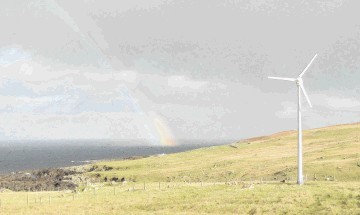
Highland and island communities could miss out on renewable-energy profits if they pursue over-ambitious windfarm schemes, experts warned yesterday.
Environmental consultancy Ecodyn says poor grid infrastructure puts north-west communities at a disadvantage.
Community windfarms can provide significant funds for local developments, as shown by Scotland’s first grid-connected community-owned windfarm at Gigha but the firm claims some areas are being disadvantaged because their grid is log-jammed.
Sleat Community Trust, on Skye, spent £9,000 and seven years on a 900kilowatt (KW) turbine project but were told they could not sell energy to the grid until 2020.
Trust manager Angus Robertson said: “The turbine was supposed to give us income for community projects for many years.
“We wanted a bigger turbine because the payback was larger but, with hindsight, a smaller project is something we should have looked at. It wasn’t until we had gone through a costly process that we learned we couldn’t export electricity until 2020.
“Our financial projections were based around exporting immediately and, if you are going to have to wait seven years, you wonder whether the project is worth doing.”
Crofter’s commission member Colin Kennedy of Coll is also struggling to get connected at the capacity he expected. He said: “I have paid for, and have everything in place for, a project over 100kw in capacity but I have been prohibited in going beyond 50kw because of grid problems. If you have your house in order, you can get a 50kw turbine now before the tariffs drop but, until things change, you won’t get anything more.”
Ecodyn director Henrik Micski fears communities holding out for the big pay-back projects will be shocked to discover they cannot connect for years, giving lower returns than expected. He said: “What we are finding is that, if communities opt for smaller projects up to 50KW now, they should not have connection problems and can start to get payback immediately. They then have an asset that banks are more likely to lend against for other community priorities such as schools or playparks.”
Recommended for you
